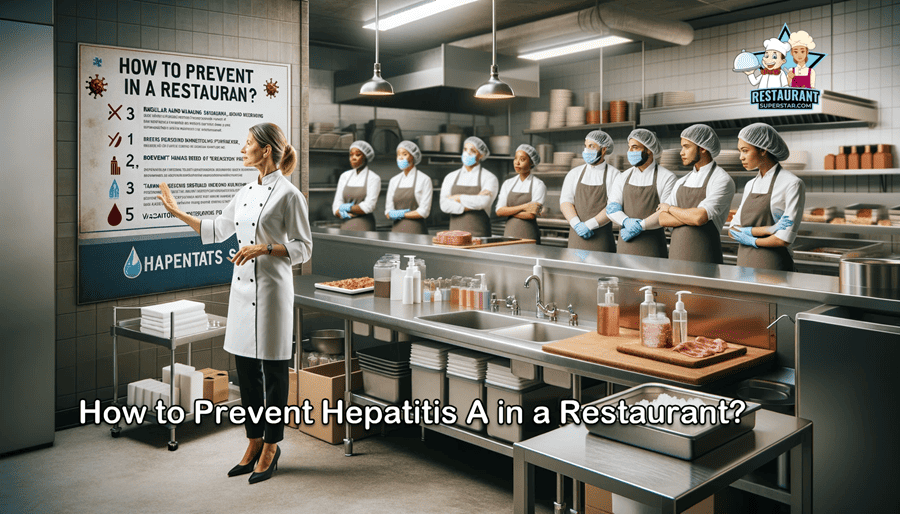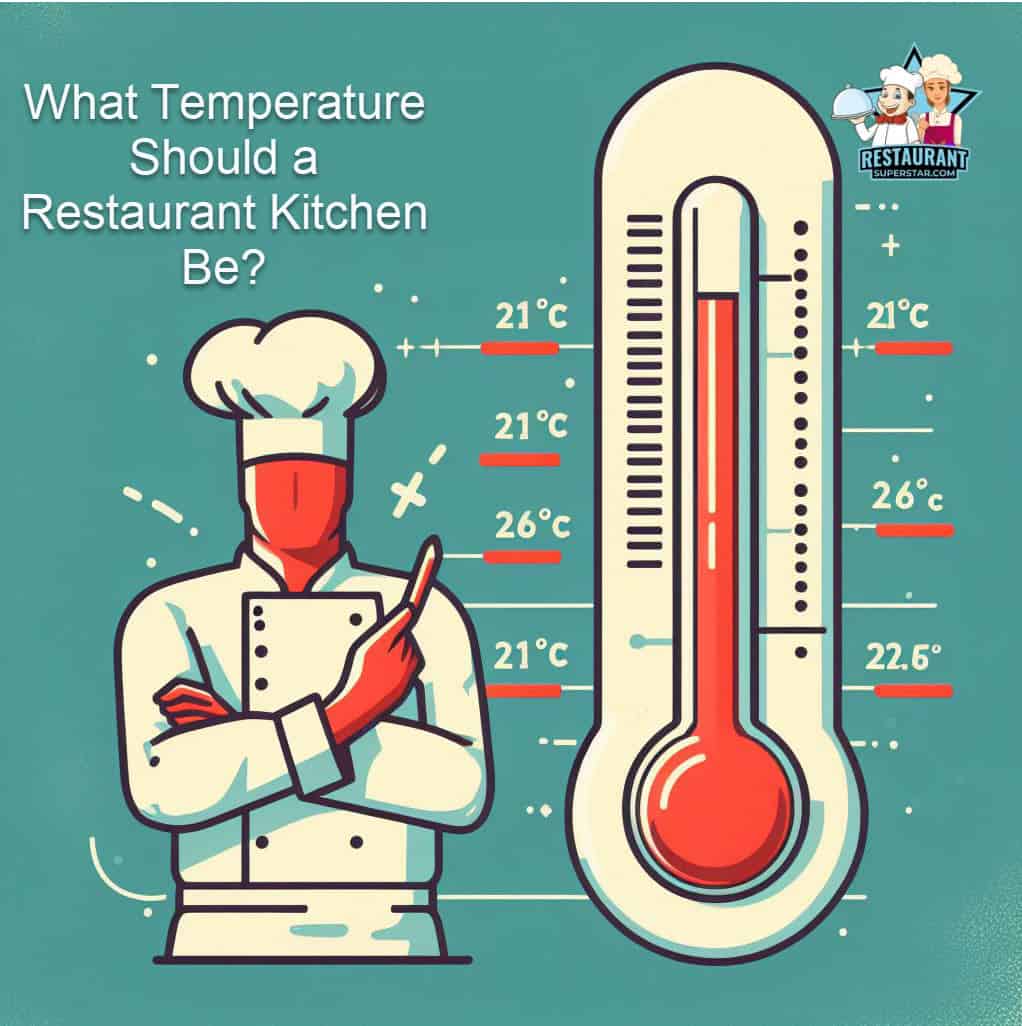How to Prevent Hepatitis A in a Restaurant?
Suppose you’re pondering the crucial question, “How to prevent Hepatitis A in a restaurant?”. In that case, you are in the right place.
This article not only answers this pivotal query but also delves deeper into a realm of essential knowledge every new restaurant owner, young chef, and curious individual should have.
How to Prevent Hepatitis A in a Restaurant?
How to Prevent Hepatitis A in a Restaurant? The answer to preventing Hepatitis A in restaurants hinges on a multifaceted approach involving stringent hygiene practices, employee vaccination, and robust food safety protocols.
Now, while this gives you a glimpse into the solution, the actual depth and breadth of this topic unfold in the upcoming sections.
This comprehensive guide will explore everything you need to know about preventing Hepatitis A in your culinary establishment.
From understanding the virus’s basics to implementing practical strategies safeguarding your staff and customers, we’ve got you covered.
Stay tuned as we dive into the nuances of creating a safe, healthy, and thriving restaurant environment free from the worries of Hepatitis A.
The Battle Against Hepatitis A in Restaurants

Hepatitis A: A Quick Overview
First things first, let’s talk about Hepatitis A. It’s a highly contagious liver infection caused by the Hepatitis A virus. Think of it as an unwanted guest that can disrupt your restaurant’s smooth sailing.
It spreads mainly through food or water contaminated by someone infected – yes, it’s as icky as it sounds. This is why restaurants can, unfortunately, become hotspots if proper precautions aren’t taken.
Why should you be extra vigilant about this as someone in the food industry? An outbreak in your restaurant isn’t just a health nightmare – it’s a PR disaster waiting to happen.
It can lead to customer mistrust, legal issues, and even forced closures. Ouch!
The Importance of Preventive Measures
Here’s where the good news comes in. Preventing Hepatitis A in your restaurant is doable, and it’s all about taking the proper steps.
This means embracing a culture of cleanliness, being smart about food handling, and, yes, even getting a little friendly with health regulations.
In the coming sections, we’re going to dive into the nitty-gritty of:
- Vaccinations: Your first line of defense.
- Hygiene Practices: Keeping those germs at bay.
- Food Handling: Doing it the right way.
- Education and Awareness: Knowledge is power!
By the end of this guide, you’ll be equipped with all the know-how to keep your restaurant Hepatitis A-free. So, let’s roll up our sleeves and get started!
Understanding Hepatitis A: What Every Restaurant Needs to Know
Alright, let’s dive into the world of Hepatitis A – it’s not the most glamorous topic, but it’s super crucial for anyone in the restaurant biz.
What is Hepatitis A?
In simple terms, Hepatitis A is a virus that attacks the liver. Think of it as a tiny troublemaker that can cause a big health mess.
It’s one of several types of hepatitis viruses, but this one’s known for being highly contagious.
It spreads mainly when a person ingests even microscopic amounts of contaminated fecal matter.
Gross, I know, but it’s the reality of what we’re dealing with.
How Does It Spread?
Now, how does this relate to restaurants? It often finds its way into kitchens through infected food handlers who might not even know they’re carrying the virus.
If they don’t wash their hands properly after using the restroom and then touch food, the virus can jump onto the food and then to anyone who eats it.
It’s also spread through contaminated water and certain foods, especially if not cooked or washed correctly.
Symptoms to Watch Out For
People with Hepatitis A might start feeling sick 2-6 weeks after infection. Symptoms can include:
- Feeling super tired (more than your usual after-a-long-shift tired)
- Stomach pain or discomfort
- Loss of appetite
- Nausea or vomiting
- Fever
- Yellowing of the skin and eyes (jaundice)
- Dark urine and pale stools
Sometimes, people don’t have any symptoms, especially kids. But they can still spread the virus, which is a sneaky problem.
Why It Matters in Food Service
In a restaurant setting, Hepatitis A can spread like wildfire if you’re not careful. It’s not just about the health of your staff and customers but also your reputation.
A Hepatitis A outbreak linked to your restaurant can mean a PR nightmare and severe damage to your business.
But don’t worry, you’ve got this! You can keep this pesky virus at bay with the proper knowledge and actions. Stay tuned as we move on to how you can armor up your restaurant against Hepatitis A.
Vaccination: Your Restaurant’s Armor Against Hepatitis A
Getting down to business, one of the most effective weapons in your arsenal against Hepatitis A is, without a doubt, vaccination. It’s like giving your team a superhero shield against this virus.
Why Vaccination is a Must in Food Service
Imagine Hepatitis A as an invisible enemy lurking around. The vaccine is like a security guard that keeps this enemy at bay. For those in the food industry, getting vaccinated isn’t just a personal health choice; it’s a critical step in protecting the dining experience.
How It Protects Everyone
Here’s the deal – when your staff gets vaccinated, they’re protecting themselves and creating a safety net for your customers. Think of it as a domino effect: if your staff is safe, your food and customers are safe. It’s a win-win-win situation!
Encouraging Vaccinations in Your Restaurant
So, how do you make this happen? It’s all about creating a culture of health and safety. Here are some steps to encourage or even mandate vaccinations:
- Educate Your Team: Host a session to discuss the vaccine’s benefits. Sometimes, it takes a little knowledge to nudge people in the right direction.
- Make It Easy: Consider partnering with a local healthcare provider to offer vaccines on-site. If that’s impossible, provide information on where your team can get vaccinated.
- Incentivize: A little motivation can go a long way. Offer a small bonus, an extra day off, or even recognize those who get vaccinated with a ‘Health Hero’ award.
- Policy Implementation: Depending on your location and the laws, consider making vaccination a part of your employment policy. Just be sure to check with legal guidelines on this.
- Lead by Example: Show your team you’re serious about safety by vaccinating yourself. Leaders who walk the talk can be incredibly persuasive.
By prioritizing vaccinations, you’re not just upkeeping health standards but also building trust. Customers love knowing that the places they eat at are as concerned about their health as they are about the taste of their food.
Employee Health and Hygiene Practices: Keeping Your Team and Customers Safe
Let’s get our hands dirty (well, not literally) with some hygiene basics. Trust me, these are your secret ingredients for health and safety in the restaurant world.
Handwashing: The MVP of Hygiene
Handwashing is like the unsung hero of hygiene practices. It’s simple, yet it packs a punch against germs. Here’s how to make sure it’s done right:
- When to Wash: Before and after handling food, after using the restroom, after touching garbage – basically, think of handwashing as an all-day event.
- How to Wash: Teach your team the 20-second rule. Wet your hands, apply soap, and scrub for at least 20 seconds (sing the “Happy Birthday” song twice, it helps). Remember the back of the hands, between fingers, and undernails.
- Handwashing Stations: Make sure these are easily accessible and well-stocked with soap and paper towels, and maybe even post a handwashing guide as a friendly reminder.
Sick Leave Policy: Keeping Illness Out of the Kitchen
Nobody wants a side of Hepatitis A with their meal, right? Here’s where a solid sick leave policy plays a significant role:
- Encourage Honesty: Make it clear that calling in sick is okay. Health comes first.
- Clear Guidelines: Set rules for common symptoms that require staying home, like vomiting, diarrhea, jaundice, or fever.
- Support System: Offer support to sick employees, whether flexible makeup shifts or help with medical advice.
Gloves and Hygiene in Food Handling
Gloves are great, but they’re not magical. They need to be used correctly:
- Training: Teach your staff when and how to use gloves – and remember, they’re not a substitute for handwashing.
- Change Frequently: Gloves should be changed often, especially when handling different foods or after any contamination risk, like touching the face or taking out the trash.
- Bare Hand Contact: Avoid it as much as possible with ready-to-eat foods. Tongs, spatulas, and other utensils can be lifesavers.
You’re setting your restaurant up for success by nailing these hygiene practices. Not only are you keeping everyone safe, but you’re also building a reputation as a place that cares – and in the food business, that’s gold.
Next, we will talk about how to handle food like a pro. Stay tuned!
Safe Food Handling and Preparation
Let’s reduce the heat and talk about safe food handling and preparation. These are like your kitchen’s safety commandments and are important in keeping Hepatitis A out of your dishes.
Cooking and Storage: The Dynamic Duo
Cooking and storing food correctly is crucial in zapping away nasty viruses like Hepatitis A. Here’s how to get it right:
- Cooking Temperatures: Know the right temperatures for different foods. Especially meat, poultry, and seafood must hit certain temperatures to kill off viruses.
- Storage Smarts: Keep your fridge and freezers at the proper temperatures (fridge at or below 40°F and freezer at 0°F). This helps slow down any virus party wanting to start in your food.
- Regular Checks: Use thermometers to check your equipment regularly. It’s like a quick health check for your fridge and oven.
Cross-Contamination: Avoid the Mix-Up
Cross-contamination is a sneaky way for germs to spread. Keep them in check with these tips:
- Separate Equipment: Different cutting boards, knives, and utensils are used for raw and cooked foods. Color-coding them can be a fun and easy way to remember.
- Clean Surfaces: After prepping each type of food, give your surfaces a good clean. Sanitizing wipes or sprays are your best friends here.
- Mind the Order: Prep your veggies and other ready-to-eat foods before handling raw meat. It’s all about keeping the raw stuff away from the cooked goodies.
Water Safety
Water in your kitchen needs to be safe, too, as it’s a common carrier of Hepatitis A:
- Safe Sources: Always use water from a safe, treated source, especially for washing ingredients and making ice.
- Boiling Water: If you’re unsure about your water source, boiling it can kill off viruses.
- Ice Matters: Remember, the virus can hitch an ice ride, too. Make sure your ice machine is clean and using safe water.
By mastering these food handling and preparation techniques, you’re not just cooking delicious meals but also serving safety and reliability on a plate. It’s a surefire way to keep your customers happy and healthy.
Next, we’ll spill the tea on keeping your restaurant spotlessly clean and virus-free. Stay tuned!
Cleaning and Sanitation Protocols
Let’s face it: cleaning might not be the most exciting part of running a restaurant, but it’s one of the most important, especially when it comes to keeping Hepatitis A at bay. So, grab those gloves, and let’s get scrubbing!
Regular Cleaning and Sanitizing: Making It a Habit
A clean kitchen is your first defense against all sorts of nasties, including Hepatitis A. Here’s how to keep things spotless:
- Daily Deep Clean: Make it a routine to thoroughly clean and sanitize your kitchen at the end of each day. This includes surfaces, equipment, and utensils.
- Spot Cleaning: Throughout the day, watch for spills or messes. Quick action can prevent cross-contamination.
- Sanitizing Solutions: Use the right sanitizing solutions. There’s a difference between cleaning (getting rid of dirt and grease) and sanitizing (killing germs). Make sure you’re doing both.
High-Touch Surfaces: Germ Hotspots
Some areas in your kitchen are like germ magnets. Pay extra attention to:
- Doorknobs and Handles: These are touched all the time. A quick wipe with a disinfectant several times a day keeps the germs away.
- Switches and Control Panels: Don’t forget about light switches, oven dials, and other control panels. A gentle wipe with a disinfectant can do wonders.
- Menus and Cash Registers: If you have a front-of-house, regularly clean items like menus and registers. Many hands touch them.
Developing a Food Safety and Sanitation Program
Every restaurant should have a solid plan. Here’s where to start:
- Follow Local Guidelines: Your local health department has guidelines for a reason. Make sure you know them and incorporate their standards into your program.
- Training Staff: Your team should know your cleaning protocols, from the dishwashers to the head chef.
- Regular Updates: Keep your program fresh. Stay updated with new health guidelines and update your practices accordingly.
By putting these cleaning and sanitation protocols into action, you’re not just keeping your restaurant tidy but ensuring it’s a safe place for your team and customers. It’s like giving your restaurant a health shield!
Next, we’ll look at how you can turn your customers into partners in this health mission. Stay tuned.
Educating and Protecting Customers
Let’s discuss a key ingredient in your restaurant’s safety recipe – your customers! Keeping them informed and involved is a big part of preventing Hepatitis A.
Hand Hygiene: Spreading the Word, Not Germs
Hand hygiene isn’t just for your staff; it’s for everyone. Here’s how you can encourage your customers to keep their hands clean:
- Visible Reminders: Make friendly, creative signs reminding customers to wash their hands, especially in restrooms.
- Hand Sanitizer Stations: Set up hand sanitizer stations at the entrance or near the dining area. It’s a gentle nudge for customers to clean their hands before they dig in.
- Engaging Content: Use your social media or website to share quick tips on hand hygiene. It’s a great way to engage with customers and spread awareness.
Information Sharing: Building Trust Through Transparency
Customers appreciate knowing that you’re on top of health matters. Here’s how you can share vital information:
- Outbreak Alerts: If there’s a Hepatitis A outbreak in your area, be proactive. Please share information about it and tell your customers what measures you take to keep them safe.
- Vaccination Info: Educate your customers about the importance of Hepatitis A vaccination. You could have flyers or posters with FAQs or a section on your website.
Empower with Knowledge
Host small events or workshops on food safety. It shows that you care and help build a community that values health.
By educating and protecting your customers, you’re not just preventing health issues but also building a relationship based on trust and care. And in the hospitality industry, that’s as valuable as the best dish on your menu.
Coming up next, let’s wrap up all we’ve learned and get you set on your journey to a Hepatitis A-free restaurant.
Regulatory Compliance and Best Practices
As we wrap up, let’s focus on the backbone of your restaurant’s health and safety practices: staying in line with regulations and continually updating your knowledge. This is where you transform from being just a restaurant owner or chef into a true guardian of public health.
Understanding Local Health Department Guidelines
Your local health department is like your guide in the complex world of food safety regulations. Here’s how to stay on top of things:
- Know the Rules: Take the time to understand what your local health department requires. This could include specific cleaning protocols, food storage guidelines, or employee health policies.
- Regular Check-Ins: Keep in touch with your local health department. Attend any meetings or seminars they offer. They’re a wealth of information and can help you stay ahead of any regulatory changes.
- Display Health Scores: Proudly display your health inspection scores. It shows transparency and reassures your customers that you’re committed to maintaining high standards.
Continual Training and Updates
The world of food safety is constantly evolving, and so should your knowledge:
- Regular Staff Training: Ensure your team is updated with the latest food safety practices. Regular training sessions can keep everyone informed and vigilant.
- Stay Informed: Subscribe to food safety newsletters, follow relevant social media accounts, or join industry groups. Staying informed about the latest trends and outbreaks can help you adapt quickly.
- Feedback Loop: Encourage feedback from your staff about the safety practices. Sometimes, the best ideas come from those on the front line daily.
By adhering to regulatory compliance and best practices, you’re not just running a business; you’re upholding a standard of excellence in food safety.
This commitment ensures the well-being of your customers and staff. It solidifies your restaurant’s reputation as a trustworthy and responsible establishment.
The journey to keeping your restaurant Hepatitis A-free is ongoing, filled with learning, adapting, and leading by example. You’ve got this.
Conclusion
We’ve cooked up quite the guide on keeping Hepatitis A out of your restaurant. Let’s do a quick recap of the key ingredients to ensure your establishment stays healthy and thriving:
- Vaccinate Your Team: This is your frontline defense. Encourage or mandate vaccinations for your staff to safeguard everyone’s health.
- Ace the Hygiene Game: Emphasize handwashing, implement a thoughtful sick leave policy, and use gloves wisely. Remember, good hygiene is the cornerstone of food safety.
- Master Safe Food Handling and Preparation: Be vigilant about cooking and storage temperatures, avoid cross-contamination, and ensure water safety. These practices are vital in serving up safety with every dish.
- Clean and Sanitize Religiously: Adopt rigorous cleaning and sanitizing routines, especially in high-touch areas. A clean kitchen is your shield against the virus.
- Educate and Engage Your Customers: Share knowledge and encourage good practices. When your customers are informed, they become health partners.
- Stay Updated with Regulations: Keep in sync with local health department guidelines and regularly train your staff. Being regulation-savvy is non-negotiable.
As a new restaurant owner, a young chef, or someone eager to make a difference in the food industry, you now have a robust playbook to tackle Hepatitis A head-on. But the learning shouldn’t stop here.
Your Call-to-Action: Dive deeper and stay informed. Visit reputable health websites like the CDC or WHO for the latest information on Hepatitis A and other foodborne illnesses. Knowledge is power, and in food safety, it’s also your best defense.
Jeff Smith is a Restaurant Consultant with over 20 years of hospitality experience ranging from server to owner and general manager. He focuses on Restaurant POS technology as well as restaurant marketing. Check out our world-famous restaurant resources page for a comprehensive offering of hand-picked resources and tools to help your business. You can also check out some of our other restaurant business articles.




